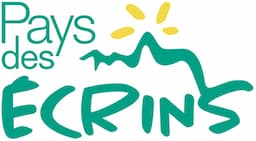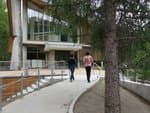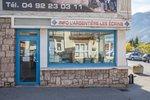Around the mines (trail route no. 22)
Description
The circuit starts at the Les Écrins campsite in L'Argentière-la-Bessée, follows the railway line for 500 metres, before crossing it to take the local road towards Le Plan Léothaud
- At the centre of the hairpin bend, go right onto a path leading to Peyre de Lière
- Go to the extreme right towards the "Ubac" (north-facing slope) and Leyrette and then climb up to the Bois de Champ Pelbaud, going through a pine forest until you come to Le Sapey
- Cross the Fournel via the bridge at Le Sapey and then head to the right towards the silver mines ("Mines d'Argent")
- Before the silver mines, head left to reach the Les Blachières road which takes you on a more open descent through fields and houses to the church and then past the industrial zone of L'Argentière-la-Bessée
- At the roundabout, turn right, then left and then right again to join the green route ("Voie Verte") to L'Argentière-la-Bessée along the banks of the Durance. Then, go back across the Fournel to the white water stadium and the starting point
- Departure : Camping Les Écrins, L’Argentière-la-Bessée
- Arrival : Camping Les Écrins, L’Argentière-la-Bessée
- Towns crossed : L'Argentière-la-Bessée
Altimetric profile
Recommandations
Before setting off, it is very important to check the opening periods for this route on the website: https://stationdetrail.com/fr/stations/le-pays-des-ecrins/parcours
Share your photographs on social networks with #stationdetrailecrins
Check weather conditions before setting off.
Rescue services contact details: Secours Montagne (Mountain Rescue): +33 (0)4 92 22 22 22 or 112
Show consideration for the work of farmers, livestock keepers and owners
Close all gates behind you
Take your litter home
Do not take shortcuts across pastureland
The trail routes are also suitable for walking
Information desks
Vallouise Park house
, 05290 Vallouise
Information, documentation, models, exhibitions, screenings, product sales and works of the Park. Guided tours for school, reservation required. The new Park House opened in Vallouise since June 1, and offers visitors an interactive permanent exhibition inviting to explore the area and its heritage. A temporary exhibition space will allow a renewed offer. Finally, the device is completed by an audiovisual room to organize screenings and conferences Free admission. All animations of the Park are free unless otherwise stated.
23 Avenue de la République, 05120 L'Argentière-La Bessée
Transport
Public transport >> www.pacamobilite.fr
Consider car-sharing >> www.blablacar.fr
Access and parking
Parking :
Sensitive areas
Short-toed snake eagle
- Impacted practices:
- Aerial,
- Sensitivity periods:
- MarAprMayJunJulAugSep
- Contact:
- Parc National des Écrins
Julien Charron
julien.charron@ecrins-parcnational.fr
Short-toed snake eagle
- Impacted practices:
- Aerial,
- Sensitivity periods:
- MarAprMayJunJulAugSep
- Contact:
- Parc National des Écrins
Julien Charron
julien.charron@ecrins-parcnational.fr
Short-toed snake eagle
- Impacted practices:
- Aerial,
- Sensitivity periods:
- MarAprMayJunJulAugSep
- Contact:
- Parc National des Écrins
Julien Charron
julien.charron@ecrins-parcnational.fr
Short-toed snake eagle
- Impacted practices:
- Aerial,
- Sensitivity periods:
- MarAprMayJunJulAugSep
- Contact:
- Parc National des Écrins
Julien Charron
julien.charron@ecrins-parcnational.fr
Short-toed snake eagle
- Impacted practices:
- Aerial,
- Sensitivity periods:
- MarAprMayJunJulAugSep
- Contact:
- Parc National des Écrins
Julien Charron
julien.charron@ecrins-parcnational.fr
10 points of interest
 Fauna
FaunaThe common chiffchaff
When spring arrives, a relentless «cheep, cheep» echoes around the forest. The singer is a small bird with a greenish grey and yellowish-white back, the common chiffchaff. Like other inconspicuous birds, the male has every incentive to make himself heard if he wants to attract the attention of a female! They are migratory and live almost anywhere where there are trees and bushes.
 Flora
FloraThe sea-buckthorn
Here and there, you come across a bush with narrow leaves which are green on their upper sides and silvery-grey underneath. Take care, the branches are spiky! In autumn, it produces acidic bright orange berries. They are very rich in vitamin C and are best as a syrup or marmalade. It is a pioneer species which colonises alluvial soils in sunny situations. It has also been used by the Mountain Terrain Restoration service to stabilise slopes prone to water runoff.
 Flora
FloraThe wild angelica
On the edges of seepage areas, the wild angelica grows. This is a tall umbellifer (the Apiaceae family) with blush white flowers and a hollow purplish stem. It is a cousin of garden angelica which grows in Northern Europe and is cultivated for its medicinal and culinary properties. The stem, the petiole (the «tail») and the leaf sheath can be candied.
 Water
WaterThe Fournel
The Fournel mountain stream gives generously. Its water makes up a large proportion of the town's drinking water, supplies the irrigation canals, is used for hydropower and offers a recreational area valuable to the local economy in the form of its canyon, located in the gorge connecting it to the Durance. Being a mountain stream, it is impetuous, but sills have been built lower down and it has been dammed to prevent natural disasters. Numerous mountain streams have received the same treatment…
 Vernacular heritage
Vernacular heritageThe silver mines
The path passes close to the silver mines which gave L'Argentière its name (argent meaning "silver"). They were first worked in the early Medieval period and later abandoned before exploitation resumed again in the nineteenth century. They were finally closed in 1908. Since 1992, the site has been the subject of archaeological excavations, with major work to clear materials carried by the Fournel when in flood. They can be visited with a guide (by appointment), leaving the visitor in awe: how much ingenuity has been involved in extracting the silver-bearing galena! Flora
FloraThe Apollo
This large white butterfly decorated with black marks and red dots, is common in warm areas where stonecrops and houseleeks grow, as these are host plants for its caterpillars. It remains common in the Alps, but is much rarer elsewhere. In fact, it is a protected species. Its movement to higher altitudes has been observed, in line with climate warming, because its eggs, which it lays on plants in summer, need a certain number of days of freezing temperatures in winter in order to hatch.
 Vernacular heritage
Vernacular heritageThe hamlets of L'Argentière
Before it was attached to the municipality of La-Bessée during the revolutionary period, L'Argentière covered this well-exposed slope, with all its hamlets from the church to Eychaillon. It was only in the second half of the nineteenth century, when the Durance was dammed and industries sprang up here, that the modern town of L'Argentière developed in the plain between the two old localities. The path takes you on a discovery of the old hamlets and their very attractive houses.
 History
HistoryThe Francis turbine
The American James Francis developed the Francis turbine between 1849 and 1855. It is a “àreaction” turbine suitable for medium-sized waterfalls (with a water head of between 15 and 500 metres). The water enters the turbine and then circulates between the turbine blades, which are fixed, while the inner wheel is mobile. The pressure at the wheel intake is greater than the pressure at the outlet.
 Water
WaterThe Durance
The Durance is the biggest river in Provence. Its source rises in the municipality of Montgenèvre at an altitude of 2,390 metres, and it flows down to meet the Rhône to the south of Avignon. This is a "pluvio-nival" river, that is to say, its flow depends on the natural addition of water due to snowmelt and rainfall. It thus constitutes a real playground for kayakers from across Europe. Water
WaterThe white water stadium
As part of its restructuring after the closure of the industrial site, the town of L'Argentière-la-Bessée opted for sports tourism, exploiting the natural elements present on the site, that is to say, water. Standing at the beginning of the longest navigable section of the Durance river, in 1993 the municipality decided to establish itself as a major white water centre by creating this stadium which covers a 400-metre stretch. So thanks to its reputation and its ideal situation, every year this stadium hosts several elite competitions at national and international level.
Source

Report a problem or an error
If you have found an error on this page or if you have noticed any problems during your hike, please report them to us here:


